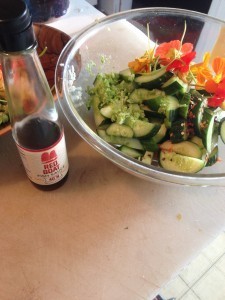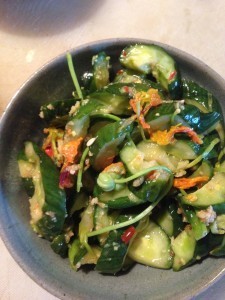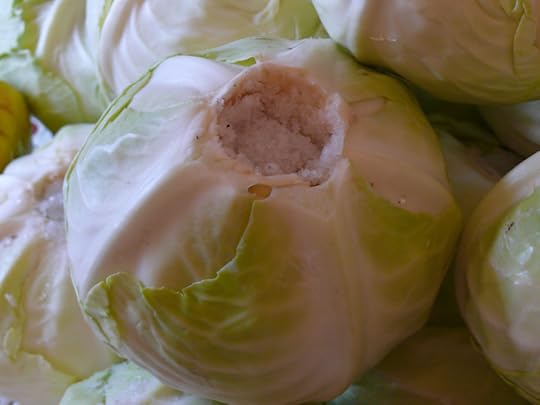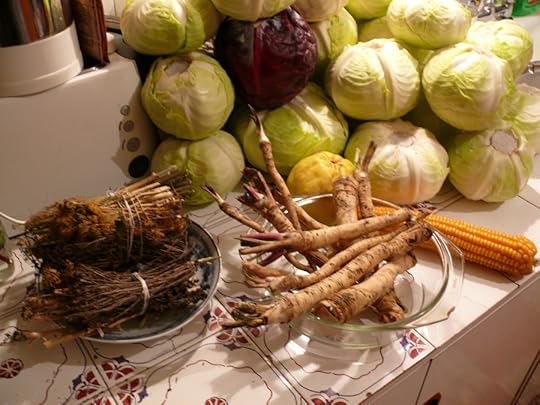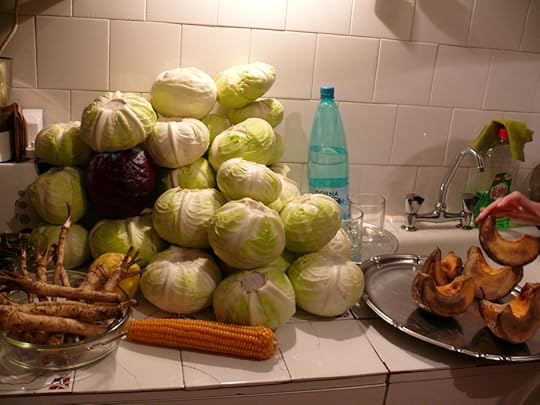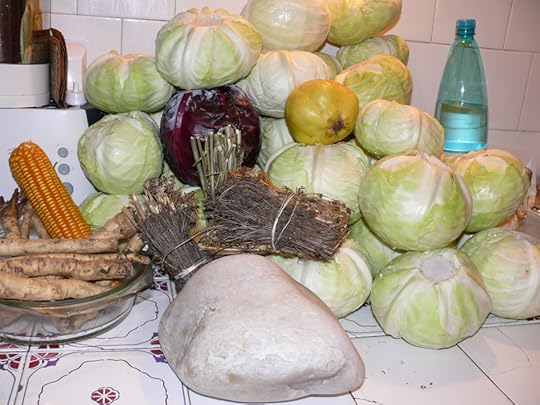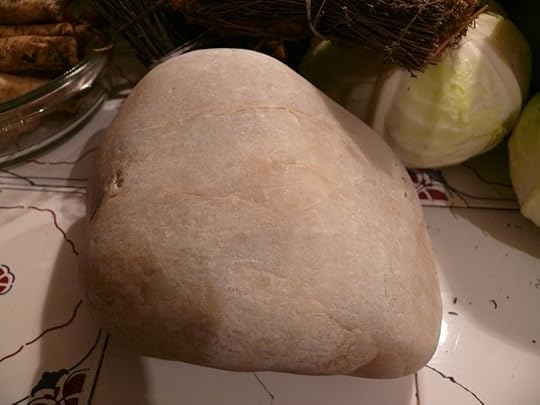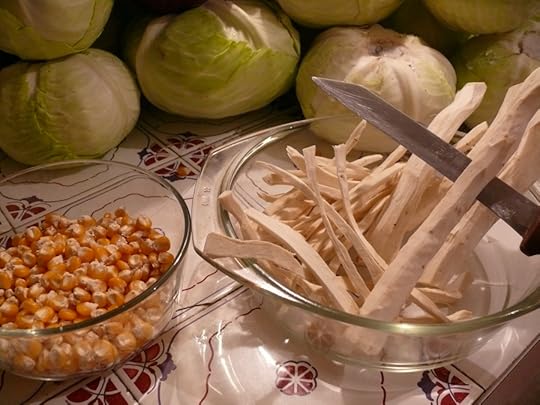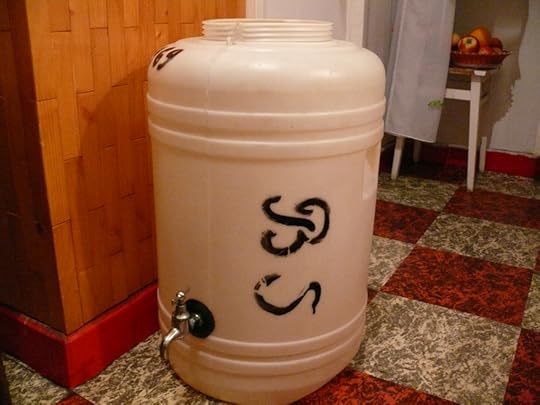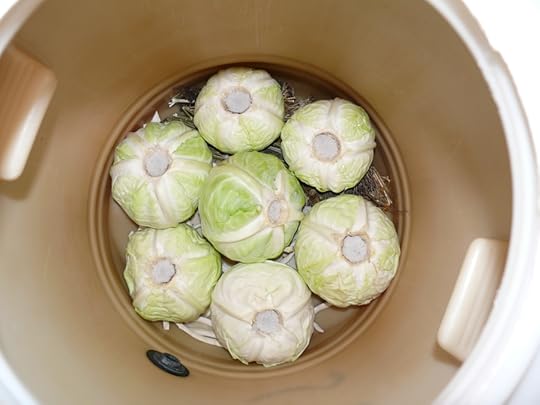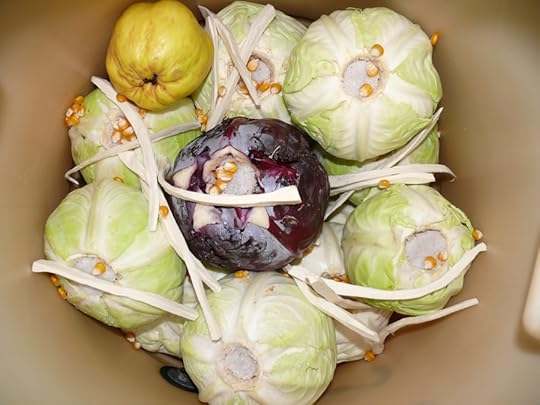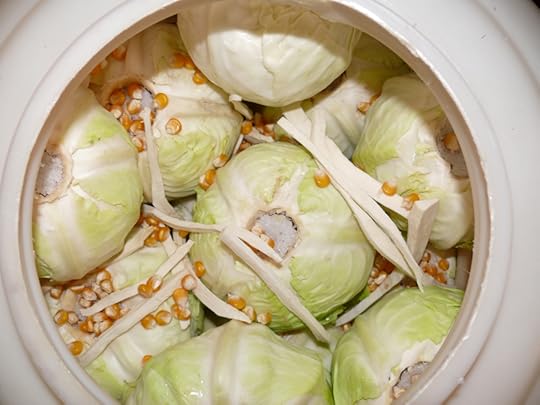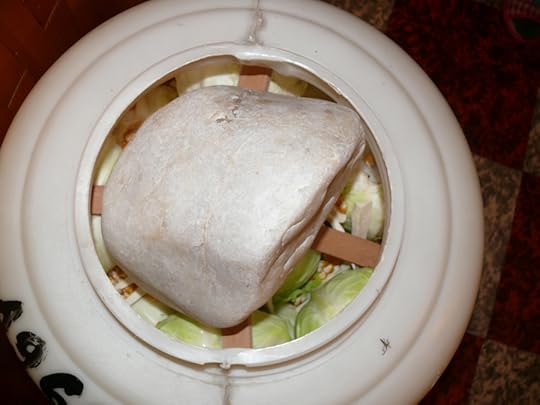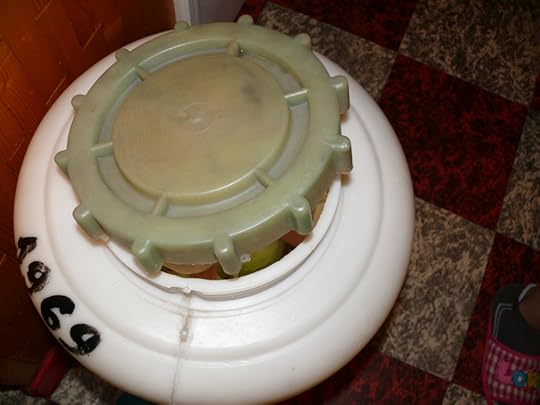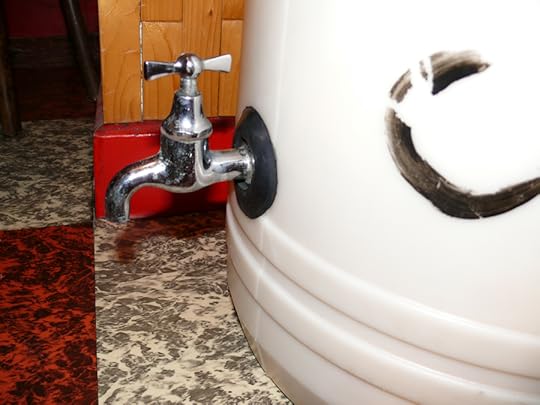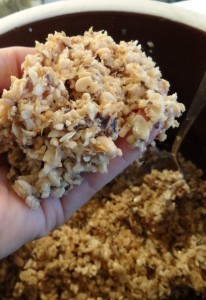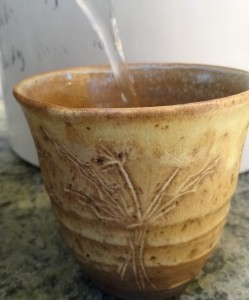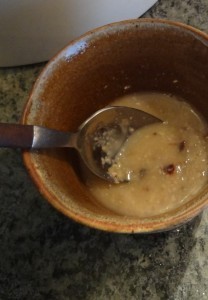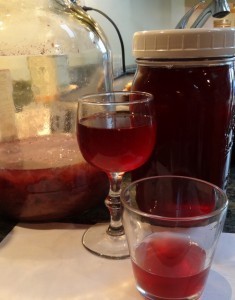Sandor Ellix Katz's Blog, page 2
July 31, 2015
June 9, 2015
Gratifying Email
From time to time I receive emails like this that remind me why spreading fermentation fervor is so important:
I want to tell you how thankful I am for your fermenting wisdom! A friend loaned me your book, I started eating some ferments each day and it has transformed my digestion.
I have been in treatment for cancer for 2 1/2 years and my bowels were becoming non-functional. Kombucha, pickles, etc., have brought me back to nearly normal. It is a miracle and I am extremely grateful!
I love your writing style and I am very inspired by your recipes.
Thank you, thank you, thank you!
February 2, 2015
Cucumber & Nasturtium Kimchee
Both cucumbers and nasturtiums can be found in full production side by side in the garden, and they combine very well for a light tasty kimchee. Cucumber kimchee is ready to eat immediately and has a very short shelf life. It’s a quick and simple kimchee that is very refreshing and easy on the palate.
Ingredients:
1 or 2 thin-skinned cucumbers, sliced.
1 small clove fresh garlic, crushed.
1 dozen or so green nasturtium seeds, crushed.
1 dozen or so nasturtium blossoms, whole.
1 T. plus 1 pinch of sea salt.
1 dash fish sauce.
1 pinch red pepper flakes.
1 dash kimchee juice, as starter.
Method:
Salt sliced cucumber with 1 T salt. Let sit for an hour or 2. Discard salty brine, rinse salt away using fresh water and drain of excess water. Add crushed garlic and nasturtium seeds, pinch of salt, dash of fish sauce, blossoms, red pepper flakes and kimchee juice and mix well. Pack in a sturdy jar and let ferment a few hours to overnight. Enjoy immediately or refrigerate to slow the fermenting process.
January 26, 2015
Molded Corn Starter for Chicha in Costa Rica
A highlight of my recent visit to Costa Rica was seeing first-hand how the indigenous Bribri people there prepare a molded corn starter for making chicha, a corn-based alcoholic beverage. Chicha is most famously prepared in the Andes mountains of South America by chewing corn in order for the corn to become saturated with salivary amylase enzymes, which break down starches into simple sugars fermentable into alcohol. I have made chicha in this way and published information on how to do this in my books Wild Fermentation and The Art of Fermentation. I had heard from travelers to the Andes that much of the chicha available there today is produced not by chewing corn but instead by malting (sprouting or germinating) corn, as barley-based beer is made. Germination also produces enzymes that break down starches into simple fermentable sugars. Then, a few months ago, when I first met Costa Rican environmental and seed activist Fabian Pacheco, he told me about this chicha made using a molded starter.
There are the three ways in which people around the world break down complex carbohydrates into simple sugars to ferment into alcohol: malting, molds, and chewing. Each of the three methods accomplishes the job. Chewing is generally regarded as the most ancient method, in contemporary use in a few different regions that I have heard about, scattered around the world. The Western tradition of beer making relies on malting, as do African sorghum beers and some Central and South American corn beers. Molds are used throughout Asia, in varied forms with names including chu, koji, marcha, nuruk, ragi, and nearly infinite local variation. Though the use of molds to make alcoholic beverages (primarily Aspergillus molds, but the traditional mold cultures are generally biodiverse) is widespread across Asia, I had never heard or read of their use in any tradition elsewhere. That is, until I met Fabian and he told me about the use of molds by the Bribri people near the Caribbean coast of Costa Rica for making their version of chicha. Fabian invited me to come to Costa Rica and took me to meet his Bribri friends, who showed us how they make this molded corn starter that they call oko in their language, and is known in Spanish as mohoso, which translates as “moldy.”
Fabian brought me to Finca Loroco, a diversified organic farm and educational center, run by his Bribri friends. The oko was already in process, being made by Mauricia Vargas, the mother of the family, in keeping with tradition around the world in which women have been the brewers. As Mauricia explained it to me, dried kernals of (starchy) corn had been soaked in water for three days. Just before our arrival, the soaked (and thus already fermenting) corn was ground into a thick paste, like a masa dough for tortillas or tamales. We participated in the next step, placing handfuls of this dough into large leaves of a plant they called bijawa (genus Calathea). Each mass of dough was wrapped like a tamale, except in two leaves. The technique was to fold the stacked leaves in half, in order to break their spines in the middle, then form the mass of dough into a rectangular shape on the stacked leaves, roughly 6 inches/15 cm high by 3 inches/7.5 cm wide and ½ inch/1 cm deep. (I did not measure, these are my estimates, and the masses varied quite a bit in size.) The important thing is that the mass be small enough to fold the leaves around them and completely enclose them.

Dough made by grinding soaked corn, bijawa leaves for wrapping it, and cooked, wrapped corn masses.

Mauricia Vargas wrapping corn dough in bijawa leaves for making oko.
The corn dough wrapped in leaves were then cooked in a big pot, most of them covered with water, but the ones at the top steamed rather than boiled. They were cooked for about an hour, then removed from the pot, and left to spontaneously ferment and mold. We did not stay for the entire fermentation period, but as Mauricia explained it to us, the wrapped corn is left undisturbed for four days. On the fifth day, the leaves are opened and the corn masses are removed. Then the leaves are turned over and the corn masses are rewrapped, with what had been the outer surfaces of the leaves in contact with the corn mass. This brings different leaf surfaces into contact with the corn mass, exposes everything to air (molds need oxygen), and seems to help to evenly distribute mold formation. After four more days, the mass is partially dried in the sun, then rewrapped, again flipping the leaves to vary surface contact. Finally, after four more days, the moldy masses are dried in the sun and ready to use or store until use.

Wrapped corn masses cooking on the fire.

Mauricia Vargas and her family, along with Fabian Pacheco, my wonderful host in Costa Rica who took me to meet them.
I participated in the initial wrapping stage only and was sent off with a couple of the wrapped corn masses to age as they described. When I first examined the corn masses after four days, mold growth was patchy. By color and by smell, I could recognize some of the mold as Aspergillus mold like those I have grown many times on rice and barley to make koji. But it showed green mold as well, indicating more than a single type of mold. Four days later, mold covered most, but still not all the surface. Some of the molds were long and hairy and clearly were sporulating. I did not remain in Costa Rica long enough to complete the process or make chicha with the oko, nor did I dare try to bring it home with me, to complete the process or send it to a lab for analysis.

Molds growth after four days.

Mold growth after nine days.
Even in this one family, there are many ways of making chicha. Most are made without the moldy oko starter. We had delicious (and strong) chicha made by removing the steamed and cooled corn masses from the leaves (without the molding process), mixing them together into a paste in a bucket, allowing this paste to ferment in a solid state for several days, then adding water and sugar and allowing the liquid to ferment for a few more days. We were also served a chicha made by adding steamed bananas to the corn paste, allowing that to ferment in a solid state, then mixing that with water immediately prior to serving. They also described chicha made with cacao and corn. Clearly chicha is not a single uniform product but rather a range of corn-based beverages, some only mildly alcoholic, others stronger. The chichas prepared without the moldy oko require sugar or bananas for fermentable simple sugars; the oko is necessary only for chicha made from just corn and water, so that the amylase enzymes from the molds can break down the starchy corn into fermentable sugars.
Due to the fact that I was not there long enough to see the process in its entirety, along with the limitations of our communications and translation, this is certainly not a comprehensive or definitive account. But because nothing (that I have come across in the English language literature) has been written about this, and because of its apparent uniqueness in the Western hemisphere, I thought it was important to share this information, incomplete as it may be. Was this practice the result of an accidental discovery, as so many fermentation processes are, with similar molds developing on grains here as across Asia? Or was there perhaps some past Asian influence here, long forgotten? The origins of fermentation practices are always shrouded in mystery. But over and over we see patterns repeated, with microbial phenomenon manifesting similarly (and at the same time uniquely) in disparate locations. Molded grains for alcohol in Central America is very exciting.
December 3, 2014
Best Fake Rolex Sale and Replica Rolex
It can be regarded to us that unique manufacturers create various replica watches, and also the price tag also may differ. A normal recognition of fine reproduction enjoy ought to have a very good movement, and very good metallic utilized, or legitimate leather etc. Whilst the simple indisputable fact that rather several replica luxurious replica check out makes have exact same movement, and replica Rolex might be the ideal illustration.
Swiss replica watches are normally trend developments from the industry. But as time goes by, the main basis for its fame isn’t any longer their classic seem, but a lot more like a symbol of social position. There are numerous persons that are wearing the replica watches being a method of identification. The main rationale which includes contributed into the level of popularity could be the top quality craftsmanship and substantial top quality components applied to create them. Should you like sporting manner add-ons in order to achieve a sophisticated look, then you definitely can think about buying the watches, they increase your search so you could make daring trend statements when with others.
Definitely, with the immediate enhancement of contemporary culture, progressively more replica view lovers become fashion-conscious. They can be constantly around the strategy for searching a thing elegant to maintain up with style pattern. Swiss replica watches are one of the most iconic components on their own desire list. Due to their fabulous seem and correct functionality, they’re considerably wanted by most keen fashionists. Although, it can be actually a fantastic incontrovertible fact that designer Swiss reproduction watches in no way come out with affordable selling prices. They are superior priced, so most consumers with confined funds need to quit the considering proudly owning just one. replica Swiss replica watches are merely to unravel the predicament.
To be a common understanding to most shoppers, the greater costly items are improved in excellent. Nevertheless the filthy small top secret about replica watches and lots of other superior grade mechanical timepieces is usually that they don’t seem to be genuinely any more exact than a $20 quartz Timex. Therefore if total precision is your purpose, then a quartz motion reproduction enjoy ought to be your purpose. Although the motion in a replica is of important significance so you may well at the same time seek out the top attainable motion. Almost all actual Rolex replica watches make use of a self-winding computerized movement that’s run from the motion within your wrist. Hence, the “perpetual” trade title. This motion is of your similar caliber as that utilised by Omega, Breitling and others. This is often pure velvet.
Lastly, everybody knows that replicas are constantly a lot cheaper than reliable variations. Normal talking, a replica timepiece basically cost $100 to $400 although an reliable one may price $1500 or even more. That is really amazing. Lots of of us may have a replica Swiss reproduction watch without needing to pay back an excessive amount. It is the time and energy to get your have substantial stop luxurious replica Rolex watches. It’s absolutely sure that these great items emphasize your social standing completely. Why not shell out minor and also have a attempt?
November 13, 2014
Tekka – a miso condiment
Once a year I clean out my fridge of old jars of miso paste. I gather up the remnants from a variety of containers, scrap off any mold, and add this to a combination of ground root vegetables. After cooking for several hours, the end result is a wonderful savory condiment, Tekka.

Tekka- miso condiment.
Finding a recipe online is an easy task, and most that come up on a web search are nearly identical in ingredients and method. I use burdock and lotus roots, carrot, ginger and sesame seeds. These are ground fine, sautéd in sesame oil, then the miso is added and the mixture is cooked and stirred all day on very, very low heat.

Tekka on delicata squash.
The end result is a rich tasting, deep brown granular sprinkle, and great on eggs, salads, mashed potatoes, and much more.

Tekka on fried eggs.
July 27, 2014
Romanian Fermented Whole Cabbage Process
I received an email from Scott in Michigan, with photos and a description of the process of fermenting whole heads of cabbage, as he observed it in Romania. See below for photos.
“I was dating a Romanian girl a couple years ago, which was my first introduction to good living. Our trips to the mountains and our visits to relatives of relatives who quite literally lived by their own two hands, and wasted nothing, changed my whole world view.”
“This is a series of pictures her mother sent me of her method for making ‘Romanian sauerkraut’ or Sour Cabbage. It’s made this way so the leaves remain whole for wrapping the Christmas ‘sarmale.’ A traditional Christmas staple of pork and cabbage. Absolutely amazing results. The best fermented cabbage I’ve ever had by far. I ate so much of this the months I spent there.”
“I do not know the exact herbs but they are not exotic, and the odd looking fruit is quince … the others are obviously horseradish and normal corn. They use the spigot to release the liquid created at regular intervals. The core of the cabbages are removed, then packed with salt… It is weighted down with 2 wood slats and a stone, then covered with the lid.”
June 13, 2014
Sandor at the River Cottage Food Fair
At the end of May, Sandor attended the River Cottage Food Fair in the UK. This is a 55-minute video of his presentation.
October 13, 2013
Raw Black-eyed Pea Miso Paste
This miso paste ferment is an experiment using all raw ingredients.
2# 6oz. raw black-eyed peas (soaked and chopped)
2# 8oz. raw barley koji
7.2 oz. salt
Lima bean miso starter (blended in water and strained)
First the koji. I soaked pearled barley over night, and it puffs up all swollen and soft. I sifted spores from a previous batch of barley koji into a hotel pan, and tossed the raw soaked barley around in the spores coating them thoroughly. Then I incubated them at 85° F for 48 hours. (There are many already-published incubation methods for koji, and I won’t go into them here.)
Next the Black-eyed peas (BEP). I soaked them for 24 hours. They swell up big, too, and get fairly soft compared to many beans. I pulsed them slightly with the S-blade in a Cuisinart™ until they were chopped medium.
I put 2 tablespoons of live lima bean miso (not raw) into a cup of water and blended thoroughly. I let it sit for 20 minutes as the solids (cooked) settled to the bottom of the cup, and then poured off the liquid, which was full of bacteria from its own lacto-ferment.
I then blended the raw barley koji with the starter water, added half the salt, and then mixed this into the chopped BEP. I packed it into a crock and put a plate and weight on top. That was 14 months ago. ( I never added more than half the salt as it was salty enough without it to my taste preference.)
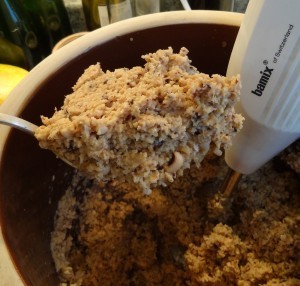 Here’s the BEP paste blended in the crock with an immersion blender. (Blending brings out lots of flavor.)
Here’s the BEP paste blended in the crock with an immersion blender. (Blending brings out lots of flavor.)
This fermented miso paste tastes much brighter than other BEP miso pastes I’ve made. It is less complex on the palette, and the flavor of the BEP comes through very strong. It is very delicious as a broth, and I have not yet experimented with it in any other dishes.
On making a cup of miso broth.
Boil good water. Fill a beautiful cup or mug with the boiling water to heat the vessel. Once hot, pour the water back into the kettle. (This cools the water in the kettle.)
Add miso paste and a little cold water, and stir to mix well.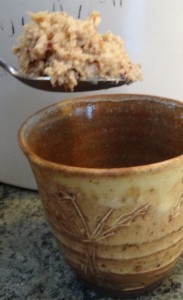
Add hot water to bring temperature up to suite your palette, without killing the miso.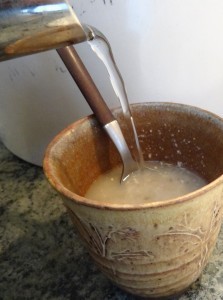
October 7, 2013
Adzuki Bean Spritzer
“Fruit punch, with hints of pomegranate.”
“An exciting alternative to champagne.”
“Very fruity with the perfect sweet/sour balance.”
“Pairs well with chocolate.”
I served this drink to friends tonight, and that’s what they had to say about it. (Then I told them what it was.)
This odd ferment is the liquid reserved from boiling adzuki beans. I often cook beans to make either miso paste or tempeh. And I usually drain the beans and discard the liquid. Lately I decided to ferment this liquid (juice, water, not sure what to call it) as it seems to contain lots of flavor and solids from cooking the beans. I let the liquid cool, then inoculate it with a couple tablespoons of juice from a batch of kimchee. I put it in a growler and top it with an airlock.
This batch is 3 months old. Lots of solids settle to the bottom, and a fair amount of coagulate floats to the surface. And in between is clear delicious fruity drink.
There is nothing about this beverage that even hints of beans. It is amazingly light, fruity and delicious, which is surprising considering what it’s made of. (Serve with dark chocolate with almonds and sea salt.)
Sandor Ellix Katz's Blog
- Sandor Ellix Katz's profile
- 250 followers



